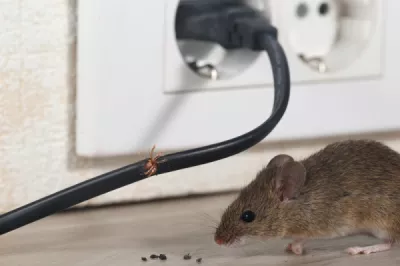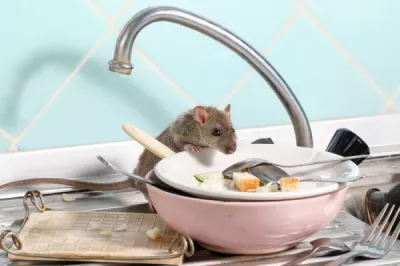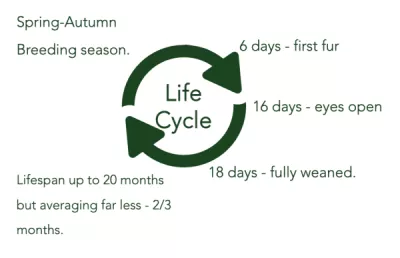Mice

Do I have a mouse problem?
Probably the most populous mammal on earth after humans. Tiny creatures that are extremely adapted to live in proximity with us. They live within the fabric of buildings and venture outside far less frequently than rats. They have the ability to completely flex their bones, so the gap they can fit to can be as small as 5mm which is about the same size as a pen.

Signs of a mouse infestation
What to look for...
- Droppings are 3-7 mm in length and may often be spindle shaped. They are soft and shiny when fresh but do not crumble easily.
- Mice give off a stale smell odour particularly in a developed infestation.
- Small mounds of dirt, dust and urine are formed - known as urine pillars.
- Mice tend to follow the same route when travelling - look for passages where dust has cleared.
- Nests tend to be made up of bits of gnawed rubbish in an undisturbed area.
- Feed on food frequently but in small portions. Look for crumbs left around food.
- They chew (a lot!). Check for holes in cables and food packaging.
Where to look...
- Mice are good climbers so look for nests/droppings high and low.
- Look in undisturbed areas cracks and crevices, corners etc.
- Avoid wet conditions in favour of dry environments.
- Nocturnal so don't expect to see a live mouse in the day.
How to get rid of mice at home
1. Housekeeping - have a thorough clean of all areas. Particularly food prep areas. Mice only need 4 grams of food a day! So even a small crumb of food is significant.
2. Begin looking for obvious gaps...
- Behind the kitchen kickboards.
- Around piping in utility cupboards etc.
- Behind large appliances.
- Underneath doors.
3. If you're handy - find a suitable material to proof them with. Something which will run across the bristles of the mouse will deter them. Scrunch up a kitchen scourer to stick in gaps. Do not use expanding foam - mice will simply chew through it.
4. Keep an eye on activity levels. Sometimes you need to engage a professional company. That's where we come in!
- Remember that glue boards are heavily legislated and use of them is recommended for professionals only.
- The rodenticides sold in shops tend to be low potency and unless placed correctly, ineffective. We don't recommend using them without a professional, BPCA registered company.
- Cut off food and water sources.
- Fit brush strips to doors close to or touching the floor.
- Look around pipes and seal any gaps.
- Inspect the perimeter - look for any gaps particularly in air bricks. Cover them with mesh.
- Keep lawns short to reduce cover.
- Trim trees and plants, particularly those close to property to shut off higher access points.
Breeding activity of rodents
Sexually Mature: 5-6 weeks
Gestation Period: 19-20 days
Litter Size: 5-8
Weaning Period: 21 days
Mice do not have to wait until the weaning is complete to conceive. Meaning 1 female mouse can produce a litter every 21 days under favourable conditions.
What do mice look like?
Size: 8-10cm body length, 7-9cm tail length
Weight: 20-25g
Fur: Light brown colour on head/body.
Other: Light brown streak of fur on underside of body.

What is rodenticide resistance? Reasons for sustainibility...
By far the most common pest we deal with is mice. Most pest control companies use rodenticide to control mice. As more and more rodenticide is applied, sometimes through poor practice, mice develop resistance to them.
For rodents such as rats and mice, this comes in 2 forms:
Base shyness - the aversion to foods that make them feel unwell.
Neophobia - apprehension to changes within the environment, so rodents are hesitant to approach control measures such as bait stations.
Increasing Effectiveness - Our Solutions
At multipest, we don't simply 'dump' poison down to solve an issue. We use a combination of control measures to not only prevent continued rodenticide resistance but primarily solve the issue for our clients in a long-term way. Finding access points, using non-toxic solutions.
- We place sufficient measures in place to control an issue and schedule follow up visits in a way that deters neophobia.
- We always follow up with our customer on a final visit basis so that rodenticide isn't left onsite indefinitely.
- We inspect the environments rather than following a 5-minute 'trap check' approach.
- Our rodenticides are always placed properly. Their effect mechanisms are delayed and this helps avoid base shyness.
Our methods of control will always look to safely proof holes and gaps and recommend methods of humane baiting that reduce the risk of dispatch in hard to reach locations (creating a bad smell).